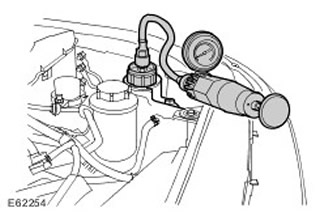NOTE: The following procedure allows you to pressure test the condition of the cooling system and check for leaks. In the 1st step, the bottle cap seal and bottle cap are checked for leaks. At the 2nd stage, the entire cooling system is checked.
NOTE: It will be necessary to use the Refrigeration Test Kit, part number LR-218, which is available through the OEM program.
1. Check the coolant hoses for cracks and deformations and the tightness of the connections.
2.
CAUTION: Because steam or coolant leaks can cause burns, allow the vehicle's cooling system to cool before performing this procedure.
Disconnect the expansion tank outlet hose. Release the clamp.
3. Install the T-piece (included in the cooling system test kit) between expansion tank and outlet hose. Secure it with two clips.
4. Install the coolant injection pump assembly. Connect the T-piece.

5. Pressurize the cooling system.
- Slowly pressurize the cooling system to 1.0 bar (100 kPa).
- Check that after 30 s the pressure is greater than 0.9 bar (90 kPa).
- When checking the pressure drop, determine if there is a hiss from the expansion tank cap.
NOTE: If expansion tank cap is leaking, replace cap.Relieve pressure in the cooling system.
- Disconnect the T-piece.
- Connect the expansion tank outlet hose.
- Fasten the clamp.
CAUTION: Because steam or coolant leaks can cause burns, allow the vehicle's cooling system to cool before performing this procedure.
Remove the expansion tank cap.
8.
NOTE: This adapter is included in the cooling system test kit.
Install the adapter K83 on the expansion tank.
- Clean the contact surfaces of the parts.
- Lubricate the seal.
- Slowly pressurize the cooling system to 1.5 bar (150 kPa) and check it after 5 minutes. Slight decrease in pressure approx. 0.15 bar (15 kPa) during the first minute is normal as the air in the expansion tank cools down.
- A continued drop in pressure below the initial tolerance indicates a coolant leak.

10. Relieve system pressure and remove pressure pump and pressure gauge. Install the expansion tank cap.

Comments on this article